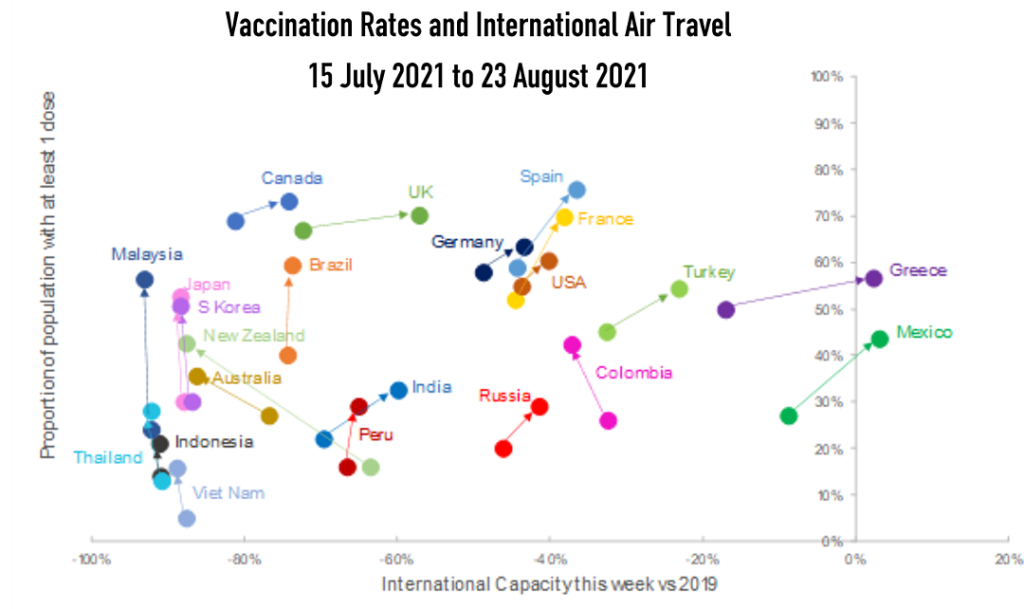However, research by aviation intelligence specialist OAG indicates that vaccination rates in and of themselves are "not a guide to how easy international air travel is" and that government policy is a "much more important determinant of airline recovery".
Studying the correlation between vaccination rates by country and international air capacity for each country relative to where capacity was two years ago, it is clear is that there is "no clear relationship" between growing international capacity and rising vaccination rates, says OAG.
While capacity appears, in general, to be improving gradually and, at the same time, the proportion of each population with at least one dose of vaccine is rising, it is absolutely "not the case that a country where more people are vaccinated is also closer to recovery in international aviation," its analysis shows.
This simple analysis doesn't show the prevalence of COVID-19 in each country, or the ability of a country to cope with infections, or even the importance of international air access for the economy through tourism or trade. "Each country shown is steering its own course based on a whole range of factors not least of which is domestic sentiment around lockdowns and the need to control spread of the virus," says OAG.
The research highlights the very wide range of responses to the pandemic, but OAG has discovered that countries can be sorted into four broad categories based on the proportion of the population that is vaccinated and the level of international capacity operating to/from the countries.

These comprise the states where vaccinations rates are reasonably high and international airline capacity is doing better than average, including France, Spain, Germany and the US. These are all developed countries that were "quick to acquire supplies of vaccines and were in a position to roll out programmes," explains OAG.
There are then the states where international air travel has continued despite a slow vaccination roll out, such as Russia and Colombia, and where most international flights available are to a relatively small group of other countries. For Russia this is Turkey, Ukraine and some of the former Soviet States, for Colombia the primary market is the USA, identifies OAG.
We then have the states where there are limited international flights taking place and vaccination levels are also low. In some of these countries vaccinations rates have been rising rapidly but these same countries - Australia, New Zealand, Malaysia, Japan and South Korea - have taken a zero-case approach to COVID-19.
All these countries have seen international air capacity fall over the last six weeks despite rising vaccination rates. An "early sense that this was an effective solution to keeping COVID-19 at bay" has now made it "hard to change the narrative that could enable more international air travel" as it will almost certainly be accompanied by higher rates of infection, explains OAG.
We then have the states where there are relatively high rates of vaccination, but remain well below average for the amount of international air travel which is possible, such as Canada and the UK, a grouping that OAG describes as "puzzling". However, there are indications in recent weeks that the levels of international travel options "may, at last, be changing," says OAG.
Outside of the quadrants highlighted in the OAG chart there are other nations that perhaps do not quite fit into any of these categories. Greece and Mexico are two such examples which either resisted travel restrictions or have sent out consistent messages about being open for travel. "As a consequence, international airline capacity is now exceeding the levels achieved two years ago," identifies OAG.
These two 'anomalies' have made inroads into their vaccination programmes with 40-60% of the population having had at least one jab, according to OAG, citing Our World in Data from mid-to-late Aug-2021. There are numerous other countries with higher vaccination rates but less air travel taking place and this perhaps - more than any other evidence - suggests that government policy, rather than vaccination rates is the best determinant of air travel recovery.